The benefits and challenge of plastic film mulching in China
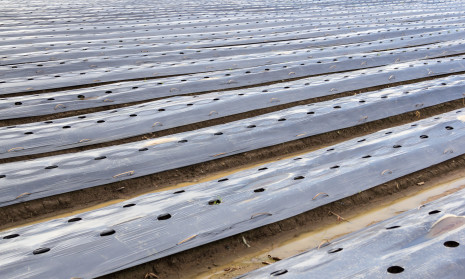
Abstract:
Plastic film mulching has played an important role in Chinese agriculture owing to its effects on soil warming, moisture conservation and weed control.
It has increased grain and cash crop yields by 20%–35% and 20%–60%, respectively. In 2014 plastic film covered 18.14 Mha and the amount of plastic film used reached 1.41 Mt.
Despite the benefits of plastic film mulch technology, widespread use has generated large amounts of mulching plastic waste.
This has adversely affected land use by reducing infiltration of water and nutrient movement. In some areas this has slowed crop emergence and irrigation water efficiency by increasing the salt content of the topsoil.
Standards for plastic film use have been improved and appropriate techniques developed for multipurpose plastic film, mechanization of residue recycling technology and replacement polythene with biodegradable plastic film.
Keywords: Plastic mulching film; Plastic film pollution; counter-measures; China
Introduction
In the past three decades, advancements in agricultural science and technology have led to great changes in agricultural production in China[1].
Plastic mulching film has become an important agriculture production material.
Plastic film mulching of seedbeds has markedly improved grain crop yields and water use efficiency through maintaining soil moisture, suppressing weeds and, increasing soil temperature.
The amount and area of plastic film have increased steadily to 1.41 Mt on more than 18.14 Mha, in 2014. Plastic film mulching has assumed a key role in ensuring the supply of agricultural goods in China.
Meanwhile, plastic film residual pollution has become more and more serious, and in some regions, the amount of plastic film residues has reached over 250 kg/ha.
In parts of Northwest China, the soil structure of farmlands has been destroyed by plastic film residues and crop growth and farming operations have been suppressed[2].
The countermeasures for agricultural plastic film residue pollution are difficult owing to low national standards, difficulty of mechanical recycling, economic considerations and lack of policy.
Role of plastic film mulching
Plastic film mulching was first developed by Japanese scientists in the 1950s[3], mainly for use in horticultural crops.
Plastic film mulching was introduced into China in the late 1970s[4].
With the development of plastic film materials and application machines, the area of plastic mulch application has expanded from the northern arid and semiarid regions to the high mountain cold regions of South China[2], especially in Inner Mongolia, Shandong, Henan and Hebei in North China, Xinjiang and Gansu in Northwest China, and Sichuan, and Yunnan in Southwest China (Fig. 1).
Plastic film mulching was used only for vegetable and flower production for several years[5], whereas now it is widely used in many cash crops, including peanut, watermelon, sugarcane and tobacco as well as grain crops such corn, wheat or rice as depicted in Fig.2.
This technology has become important to increase yields, advance harvests, reduce herbicide and pesticide consumption, provide frost protection and improve water conservation[6].
It has led to increases of 20%–50% in grain crop yield and plays a key role in ensuring the supply of agricultural goods in China.
According to the China Agricultural Statistical Yearbook[5], the amount of plastic film in China increased nearly five-fold from 0.31 to 1.41 Mt from 1991 to 2014; an annual average growth of 7.1%. Further increases are expected in future.
The total crop area covered with plastic film mulch increased from 5.72 to 18.14 Mha between 1993 and 2014 (Fig. 3).
The plastic film utilization intensity index (kg·ha-1·yr-1), first developed by Changrong Yan[2], reflects the increasing use of plastic film mulching in a region. It is calculated by dividing the quantity used (kg) by the total agricultural area (ha) in the region every year.
The data show that Xinjiang had the largest use intensity of mulch plastic films, 34.8 kg/ha in 2011, mainly because of the special climate and agricultural activities in this region[8-10].
Higher intensity indices were also detected in primary maize and cotton production areas in the northwestern regions, groundnut production in the northeastern region, groundnut and cotton production in the northern region, and tobacco production in the southwestern region.
Nationwide, the technology has led to a 20%–35% increase in grain crop yield and a 20%–60% increase in cash crop yield. Maize, wheat, cotton and potato yields have increased by 33.7%, 33.2%, 26.1% and 36.7%, respectively, while their corresponding water use efficiency levels have increased by 38.9%, 30.2%, 30.2% and 37.8%,respectively[11].
Modern cultivation technology, incorporating mulching with plastic film together with drip irrigation, can increase soil temperatures and conserve soil moisture[12,13], resulting in increased crop production.
Drip irrigation under plastic mulching has become a new irrigation system that increased crop yield providing significant economic benefits in Xinjiang, northwest China. The water savings and yield increases were respectively, 42.0% and 32.4% for cotton and 55.6% and 37.6% for tomatoes.
Effects of plastic film mulching
Plastic mulching film has various effects including increasing the soil temperature, intensifying sunlight, preserving soil moisture to reduce drought, improving fertilizer use efficiency, conserving soil, and reducing weed growth[11,14,15].
Water stress is recognized as the main limiting factor for crop growth in many parts of China, particularly in the semiarid and arid northwestern regions[16].
In those regions, approximately 80% of the rainfall in summer can be lost through evaporation from the soil without mulching. Film mulching is effective in reducing evaporation, while still allowing rainfall water to penetrate the soil [17].
Film mulching helps minimize evaporative water loss, so that more water reduces crop water stress.
In the arid and semiarid regions of northwest China, low air and soil temperature, especially overnight, hinder germination and retard vegetative growth of the major crops such as maize and wheat[18,19].
Film mulching can increase the temperature of topsoil (5 cm depth) by 1.8-2.7°C during spring (Fig. 4), and up to 6.8°C [20].
Accordingly, film mulching has led to earlier crop sowing dates, expansion of crop planting areas, regional planting structure changes and large increases in crop yield in recent years.
From 2012 to 2015, film mulching technology has been applied to 66.7 to 80 Mha, which has accounted for the total rye and wheat planting area[19], with an estimated subsequent increased production of 10-15 million tonne[2].
The main problems and their countermeasures
Despite the benefits of plastic film mulch technology, its widespread use has generated large amounts of mulch residue, evolving from a ‘white revolution’ to ‘white pollution’ in China[22].
The plastic film used is mainly composed of polythene and so used mulch film does not readily degrade in soil. The problem is worsened by the low rate of plastic film mulch recovery, owing to mechanized cultivations and the thin film.
As illustrated in Fig. 5, residual mulch levels of 50–260 kg/ha have been detected in arable spoils following over 10 years of plastic film use[11].
Large amounts of residual mulch film can make farmland unusable and thereby affect the agricultural environment[11, 23], mainly through reduced water and nutrient movement, the emergence rate of cotton seeds, and increases in the salt content of the top soil after mulching fields for 5–20 consecutive years (Fig. 6).
The hazard of plastic mulch has led to three ways of reducing reside pollution:
(1)A multipurpose plastic film technique to decrease input of plastic mulching film, has been adopted in rain-fed crop regions of Northwest China.. After harvesting, the plastic film can be utilized for a second crop, reducing plastic film use and saving time and labour.
In Gansu province, a plastic mulching film reused for a maize crop shows that the technique has potential (Fig.7).
2) Recovery of plastic film residue by machine is common now in China, and several kinds of machines such as rollers, or rakes are available.
The combination of a plastic reclaiming and a sowing machine (Fig. 8) is needed to ensure high working efficiency, and to decrease labour and machine input, but as of now, this machine is still at a development stage[24].
In general, because the plastic film on the soil is weak and easily broken-up, the extent of recovery is inadequate in the presence of straw, especially with a high density crop.
3) A very important counter-measure for the reduction of residue pollution is the replacement of polyethene with a biodegradable plastic film.
It has been predicted that this has a great potential and will become dominant in future. Compared with polyethene plastic film, the advantage of degradable plastic film is that it is environmentally bio-degraded so overcoming pollution.
However, there are several challenges confronting biodegradable film application on a large scale, including: improving its physical quality for machine operation[25], enhancing the ability of the film to increase soil temperature and to preserve soil moisture, and finally reducing cost of agricultural production.
Acknowledgements
This research was supported by Consulting Project named “The strategy of Plastic mulching and residual pollution prevention and control in China (2017-XZ-18)” form Chinese Academy of Engineering, and the Public Welfare Industry (agriculture) Special Funds Scientific Research Projects (No. 201503105).
References
1. Zhang, F., Chen, X.,Vitousek, P. Chinese agriculture: An experiment for the world. Nature, 2013, 497(7447): 33–5.
2. Yan C R, He W Q, Liu S. Application of mulch films and prevention of its residual pollution in China. Beijing: Science Press, 2015: 43–52 (in Chinese)
3. Xi Kangmin, A profile of the plastic film mulching cultivation in Japan, New Agriculture, 1981,2:28-29
4. The institute of vegetables, Chinese academy of Agricultural Sciencesm, Plastic film mulching cultivation in 1979,Agricultural science and technology communication, 1980,5:16-16
5. Yang H D. Plastic mulching film and ecological environmental protection. Beijing: Chemical Industry Press, 2000: 110–113 (in Chinese)
6. Giacomo Scarascia Mugnozza, Carmela sica, Giovanni russo. Plastic materials in Europe agriculture: actual use and perspectives, Journal of Agricultural Engineering, 2011, 3, 15–28
7. National Bureau of Statistics of China. China Statistical Yearbook. Beijing, China: China Statistics Press. 1982–2014 (in Chinese)
8. Ministry of Agriculture P. R. China. China agricultural statistics yearbook. Beijing: Chinese Agricultural Press. 1992 (in Chinese)
9. Ministry of Agriculture P. R. China. China Rural Statistical Yearbook, Beijing: Chinese Agricultural Press. 2002. (in Chinese)
10. Ministry of Agriculture P. R. China. China Rural Statistical Yearbook, Beijing: Chinese Agricultural Press, 2012. (in Chinese)
11. Yan C R, He W Q, Mei X R. Agricultural application of plastic film and its residue pollution prevention. Beijing: Science Press, 2010 (in Chinese)
12. Ibarra-Jimenez, L., Zermeno-Gonzalez, A., Munguia-Lopez, J.,Quezada-Martin, M. A. R., De La Rosa-Ibarra, M. Photosynthesis, soil temperature and yield of cucumber as affected by colored plastic mulch. Acta Agricultural Scandinavica, Section B — Soil & Plant Science. 2008, 58(4): 372–378.
13. Zhang, S. L., Lovdahl, L., Grip, H., Tong, Y. N., Yang, X. Y., Wang, Q. J. Effects of mulching and catch cropping on soil temperature, soil moisture and wheat yield on the Loess Plateau of China. Soil and Tillage Research. 2009, 102(1): 78–86.
14. Li F., Wang J., Xu J. Z., Xu H. L. Productivity and soil response to plastic film mulching durations for spring wheat on entisols in the semiarid Loess Plateau of China. Soil and Tillage Research, 2004, 78: 9–20.
15. Wang H B, Gong D Z, Mei X R, Hao W P. Dynamics comparison of rain-fed spring maize growth and evapotranspiration in plastic mulching and un-mulching fields. Transactions of the CSAE. 2012, 28(22): 88–94 (in Chinese)
16. Ren, X., Chen, X., Jia, Z. Effect of rainfall collecting with ridge and furrow on soil moisture and root growth of corn in semiarid northwest China. Journal of Agronomy & Crop Science. 2010, 196, 109–122
17. Li X, Su D, Yuan Q. Ridge-furrow planting of alfalfa (Medicago sativa L.) for improved rainwater harvest in rainfed semiarid areas in Northwest China. Soil and Tillage Research, 2007, 93, 117– 125
18. Engels, C., Munkle, L., Marschner, H. Effect of root zone temperature and shoot demand on uptake and xylem transport of macronutrients in maize (Zea mays L.). Journal of Experimental Botany, 1992, 43, 537–547.
19. White, P., Cooper, H., Clarkson, D., Earnshaw, M, Loughman, B. Effects of low temperature on growth and nutrient accumulation in rye (Secalecereale) and wheat (Triticumaestivum). Annals of Botany. 1991, 68, 23–31
20. Wang X L, Li F M, Jia Y, Shi, W Q. Increasing potato yields with additional water and increased soil temperature. Agriculture Water Management. 2005, 78, 181–194
21. Li R, Wang M, Jia Z K, Hou X Q, Yang B P, Han Q Y, Nie J F, Zhang R. Effects of different mulching patterns on soil temperature, moisture water and yield of spring maize in Weibei Highland. Transactions of the CSAE, 2012, 28(2): 106–113 (in Chinese)
22. Liu E K, HE W Q, Yan, C R. ‘White revolution’ to ‘white pollution’—agricultural plastic film mulch in China. Environmental Research Letters, 2014.9 (9).
23. Chang R P and Yan C R. Research report on overall current situation on agricultural plastics residuals pollution and its countermeasures. Beijing: China Agricultural Science and Technology Press, 2012.
24. Cao S L, Wang X J, Wang M, He Y C, Liu Y. Design and experimental research on 1LZ series combined tillage machine. Acta Agriculturae Boreali-Occidentalis Sinica. 2012, 21(5): 202–206
25. Zhao C X, He W Q, Liu S, Yan C R, Cao S L. Degradation of biodegradable plastic mulch film and its effect on the yield of cotton in Xinjiang region, China. Journal of Agro-Environment Science. 2011, 30(8): 1616–1621 (in Chinese)
Download pdfFigures
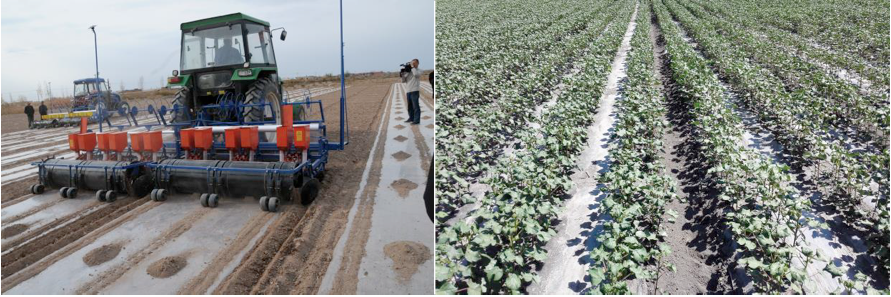
Fig. 1 Illustration of applying plastic film mulch (left) and an established young cotton crop (right) in Xinjiang, China (Photo by Changrong Yan )
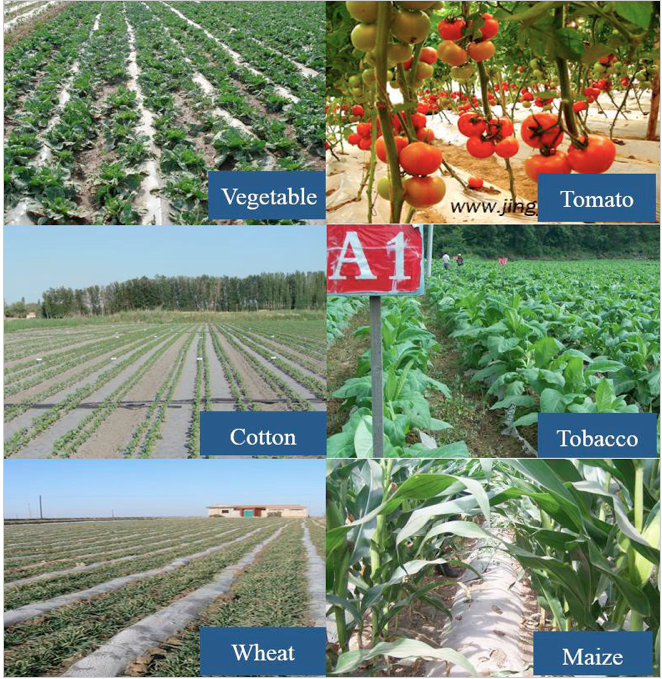
Fig. 2 Examples of crops grown with plastic film mulching in China
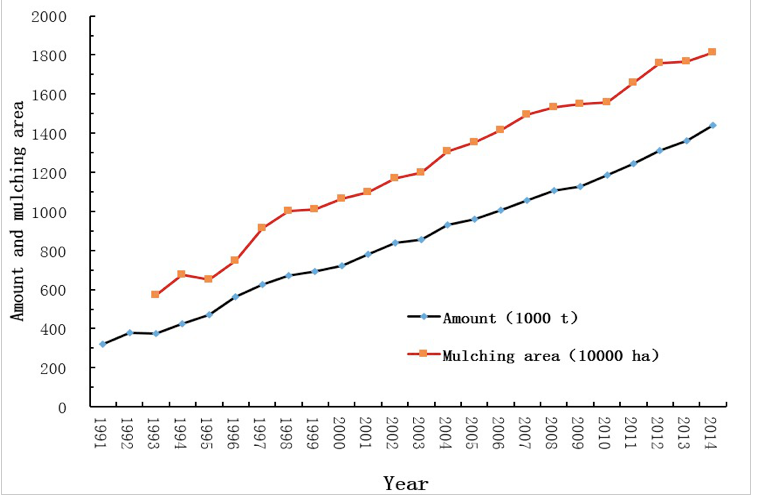
Fig. 3 The amount and crop area covered with plastic film from 1992 to 2014 in China (Changrong Yan)
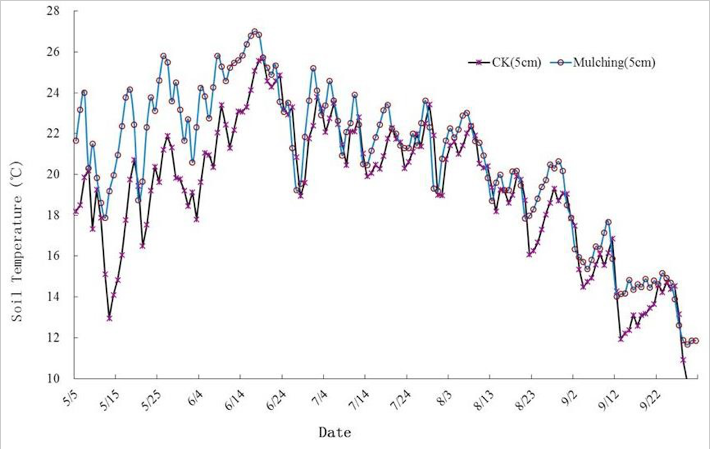
Fig. 4. The soil temperature recorded in a rainfed maize field on the Loess Plateau, China(2013, Wenqing He)
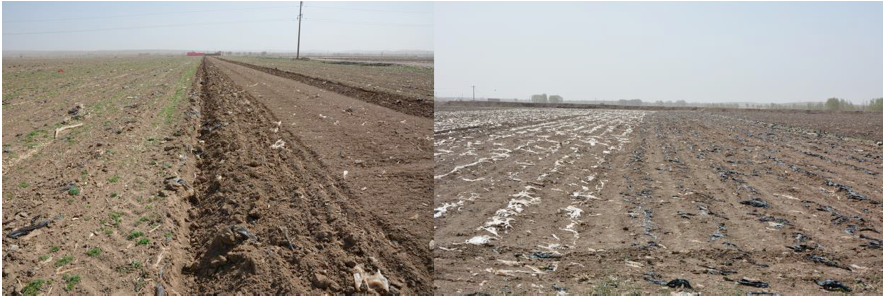
Fig. 5 Illustrations of plastic residue pollution in Inner Mongolia, China (Photo by Changrong Yan)

Fig. 7 The multipurpose plastic film showing reuse for maize in the Loess plateau, China, Photo, Tinglu Fan.

Fig. 8 The recovery of plastic film in cotton field in Xinjiang, China (Photo by Chanrong Yan)

